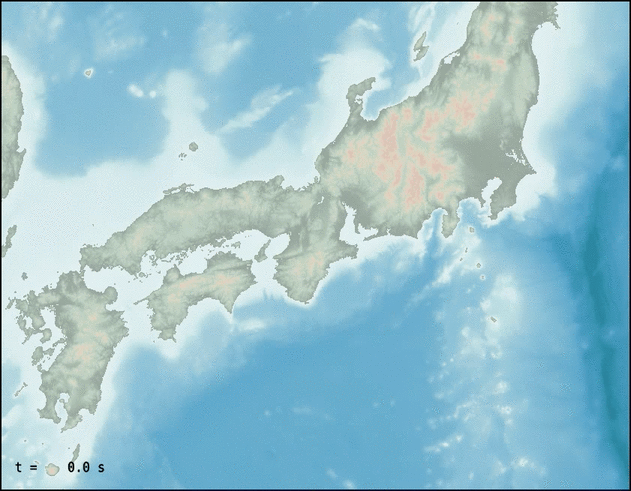Corresponding Author: Takuto Maeda
This software simulate seismic wave propagation by solving equations of motion with constitutive equations of elastic/viscoelastic medium by finite difference method (FDM) under message passing interface (MPI) environment in 3D and 2D (P-SV or SH) media.
This package also provides a set of tools for visualizing/converting simulation output.
MIT License. Please see LICENSE file for details.
The author request that the user cite (at least one of) the following accompanying paper or related papers in any publications that result from the use of this software, although this is not an obligation.
The newest release and archived versions: https://github.com/takuto-maeda/OpenSWPC/releases
The development snapshot: https://github.com/takuto-maeda/OpenSWPC/archive/develop.zip
Maeda, T., S. Takemura, and T. Maeda (2017), OpenSWPC: An open-source integrated parallel simulation code for modeling seismic wave propagation in 3D heterogeneous viscoelastic media, Earth Planets Space, 69, 102. doi:10.1186/s40623-017-0687-2
Furumura, T. and L. Chen (2004), Large scale parallel simulation and visualization of 3D seismic wavefield using the Earth Simulator, Comp. Model. Eng. Sci., 6, 153-168. doi:10.3970/cmes.2004.006.153
Furumura, T. and L. Chen (2005), Parallel simulation of strong ground motions during recent and historical damaging earthquakes in Tokyo, Japan, Parallel Computing, 31, 149-165. doi:10.1016/j.parco.2005.02.003
Furumura, T. Hayakawa, M. Nakamura, K. Koketsu, and T. Baba (2008), Development of long-period ground motions from the Nankai Trough, Japan, earthquakes: Observations and computer simulation of the 1944 Tonankai (Mw 8.1) and the 2004 SE Off-Kii Peninsula (Mw 7.4) earthquakes, Pure Appl. Geophys., 165, 585-607. doi:10.1007/s00024-008-0318-8
Furumura, T. and T. Saito (2009), An integrated simulation of ground motion and tsunami for the 1944 Tonankai earthquake using high-performance super computers, J. Disast. Res., 4, 118-126. https://www.fujipress.jp/jdr/dr/dsstr000400020118/
Noguchi, S., T. Maeda, and T. Furumura (2013), FDM simulation of an anomalous later phase from the Japan Trench subduction zone earthquakes, Pure Appl. Geophys., 170, 95-108. doi:10.1007/s00024-011-0412-1
Maeda, T., and T. Furumura (2013), FDM simulation of seismic waves, ocean acoustic waves, and tsunamis based on tsunami-coupled equations of motion, Pure Appl. Geophys., 170, 109-127. doi:10.1007/s00024-011-0430-z
Maeda, T., T. Furumura, S. Noguchi, S. Takemura, S. Sakai, M. Shinohara, K. Iwai, S. J. Lee (2013), Seismic and tsunami wave propagation of the 2011 Off the Pacific Coast of Tohoku Earthquake as inferred from the tsunami-coupled finite difference simulation, Bull. Seism. Soc. Am., 103, 1456-1472. doi:10.1785/0120120118
Maeda, T., T. Furumura, and K. Obara (2014), Scattering of teleseismic P-waves by the Japan Trench: A significant effect of reverberation in the seawater column, Earth Planet. Sci. Lett., 397, 101-110. doi:10.1016/j.epsl.2014.04.037
Noguchi, S., T. Maeda, and T. Furumura (2016), Ocean-influenced Rayleigh waves from outer-rise earthquakes and their effects on durations of long-period ground motion, Geophys. J. Int., 205, 1099-1107. doi:10.1093/gji/ggw074
Takemura, S., T. Maeda, T. Furumura, and K. Obara (2016), Constraining the source location of the 30 May 2015 (Mw 7.9) Bonin deep-focus earthquake using seismogram envelopes of high-frequency P waveforms: occurrence of deep-focus earthquake at the bottom of a subducting slab, Geophys. Res. Lett., 43, 4297-4302. doi:10.1002/2016GL068437
Yoshimitsu, N., T. Furumura, and T. Maeda (2016), Geometric effect on a laboratory-scale wavefield inferred from a three-dimensional numerical simulation, J. Appl. Geophys., 132, 184-192. doi:10.1016/j.jappgeo.2016.07.002
Maeda, T., K. Nishida, R. Takagi, and K. Obara (2016), Reconstruction of a 2D seismic wavefield by seismic gradiometry, Prog. Earth Planet. Sci., 3, 31. doi:10.1186/s40645-016-0107-4
Todoriki, M., T. Furumura, and T. Maeda (2017), Effects of seawater on elongated duration of ground motion as well as variation in its amplitude for offshore earthquakes, Geophys. J. Int., 208, 226-233. doi:10.1093/gji/ggw388
Toya, M., A. Kato, T. Maeda, K. Obara, T. Takeda, and K. Yamaoka (2017), Down-dip variations in a subducting low-velocity zone linked to episodic tremor and slip: a new constraint from ScSp waves, Scientific Reports, 7, 2868. doi:10.1038/s41598-017-03048-6
Morioka, H., H. Kumagai, and T. Maeda (2017), Theoretical basis of the amplitude source location method for volcano-seismic signals, J. Geophys. Res., 122, 6538-6551. doi:10.1002/2017JB013997
